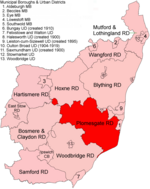Campsey Priory, (Campesse, Kampessie, etc.), was a religious house of Augustinian canonesses at Campsea Ashe, Suffolk, about 1.5 miles (2.5 km) south east of Wickham Market. It was founded shortly before 1195 on behalf of two of his sisters by Theobald de Valoines (died 1209), who, with his wife Avice, had previously founded Hickling Priory in Norfolk for male canons in 1185. Both houses were suppressed in 1536.
Campsey Priory was one of a group of monasteries in south-east Suffolk with interconnected histories, associated with the family of the elder Theobald de Valoines (Valognes, Valeines etc.), Lord of Parham (fl. 1135). These include Butley Priory (founded 1171) and Leiston Abbey (1182–83), both founded by his son-in-law Ranulf de Glanville, Chief Justiciar of England, husband of his daughter Bertha. Her sister Matilda was mother of Hubert Walter, Theobald Walter and Osbert fitzHervey. The founder of Campsey Priory was the son of Robert de Valoines and heir to the estate of Parham. During the 14th century the priory enjoyed the special patronage of the de Ufford Earls of Suffolk and their family. Maud of Lancaster, Countess of Ulster was a commanding presence, by whose efforts Bruisyard Abbey was established from Campsey.Much of the fabric of the priory was plundered after the suppression or incorporated into later buildings, but some remains were recorded during the 18th century. The site is now a private residence and not accessible to the public. Occasional excavations have been conducted. A very extensive list of documentary sources is given by Bishop Tanner; additional grants and other documents are held in the Suffolk Records, and some early books associated with the priory survive.











